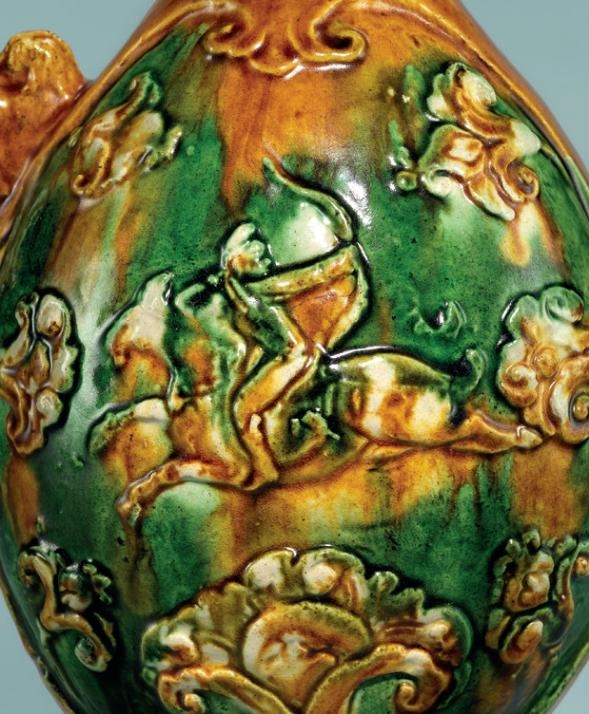A rare sancai-glazed phoenix-head ewer, Tang dynasty (618-907)
Lot 3110. A rare sancai-glazed phoenix-head ewer, Tang dynasty (618-907), 13 in. (33 cm.) high, box. Estimate HKD 500,000 - HKD 700,000. Price realised HKD 687,500 © Christie's Images Ltd 2017
The pear-shaped body is moulded on one side with an equestrian archer turned backwards on his galloping horse as he takes aim with his bow, and on the reverse with a triumphant phoenix, both surrounded by ornate flowers issuing from the oval surround, the neck surmounted by a phoenix head grasping a pearl in the beak below the oval opening in the top of the head, the C-form handle with foliate terminals, covered overall with a mix of amber, green and cream glaze, leaving the foot unglazed revealing the pinkish-white body.
Provenance: Acquired in Hong Kong, 6 April 1987
Note: The exotic design exhibited on this ewer, such as the hunting scene and rich foliage on the body, was inspired by Sassanian metal flasks which came into China through merchants and diplomats from Central Asia. One possible prototype is a fifth-century Sassanian giltsilver flask of similar shape but without a phoenix head, decorated with figural motifs, unearthed from the tomb of Li Xian in Ningxia, exhibited in The Silk Road: Treasures of Tang China, The Empress Place Museum, Singapore, 1991, catalogue, p. 24. An earlier Chinese example which might have inspired the design of the current ewer is a celadon phoenix-head ewer with rich relief designs and a dragon handle, dating to the Sui to early Tang dynasty, now in the Beijing Palace Museum Collection, illustrated in Sekai Toji Zenshu, vol. 11, Sui Tang, Tokyo, 1976, pl. 6.
A number of similar ewers can be found in important museums and institutions worldwide, including one in the British Museum Collection, illustrated by Jessica Rawson, The British Museum Book of Chinese Art, London, 1992, fig. 199; another one, which is similarly decorated on one side with a triumphant phoenix, but on the other side with a foreigner riding on a lion, illustrated in Sekai Toji Zenshu, op. cit., pls. 40-41; and one in the Tokyo National Museum Collection, illustrated by Margaret Medley, T’ang Pottery & Porcelain, London, 1981, pl. 19.
The result of C-Link Research & Development Limited thermoluminescence test no. 3407TL02 (9 November 2006) is consistent with the dating of this lot.
Christie's. The Imperial Sale / Important Chinese Ceramics and Works of Art, 31 May 2017, Convention Hall

/https%3A%2F%2Fprofilepics.canalblog.com%2Fprofilepics%2F1%2F0%2F100183.jpg)
/https%3A%2F%2Fstorage.canalblog.com%2F03%2F02%2F119589%2F96711876_o.jpg)
/https%3A%2F%2Fstorage.canalblog.com%2F11%2F31%2F119589%2F94773502_o.jpg)
/https%3A%2F%2Fstorage.canalblog.com%2F20%2F83%2F119589%2F94772815_o.jpg)
/https%3A%2F%2Fstorage.canalblog.com%2F26%2F72%2F119589%2F75604929_o.jpg)
/https%3A%2F%2Fstorage.canalblog.com%2F59%2F60%2F119589%2F26458628_o.jpg)




/image%2F1371349%2F20240309%2Fob_b308fe_getcollectionimage.jpg)
/image%2F1371349%2F20240304%2Fob_91d722_telechargement-14.jpg)
/http%3A%2F%2Fstorage.canalblog.com%2F85%2F43%2F119589%2F129846067_o.jpg)
/http%3A%2F%2Fstorage.canalblog.com%2F15%2F52%2F119589%2F129772147_o.jpg)